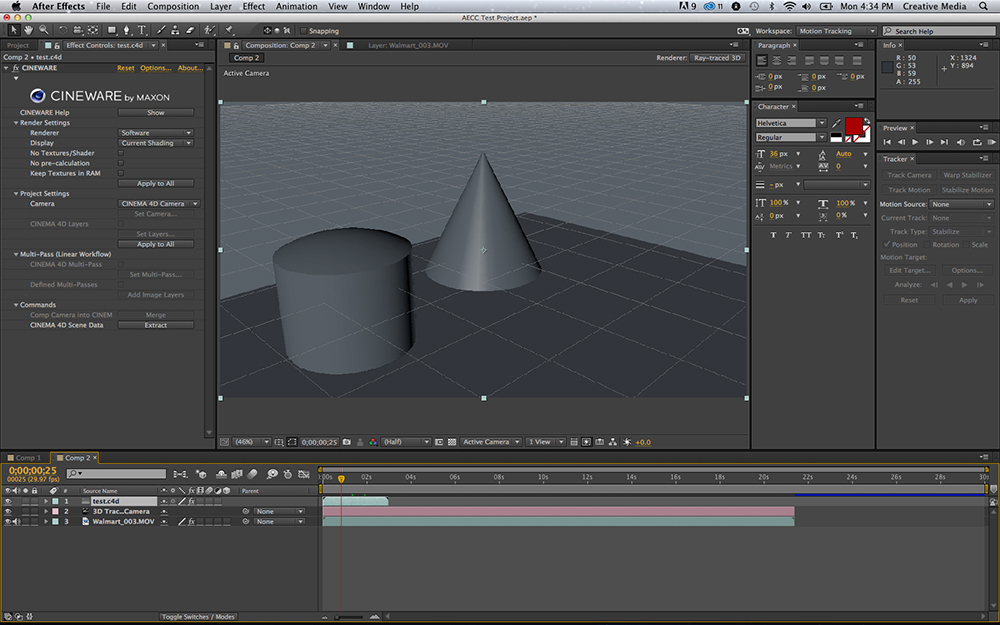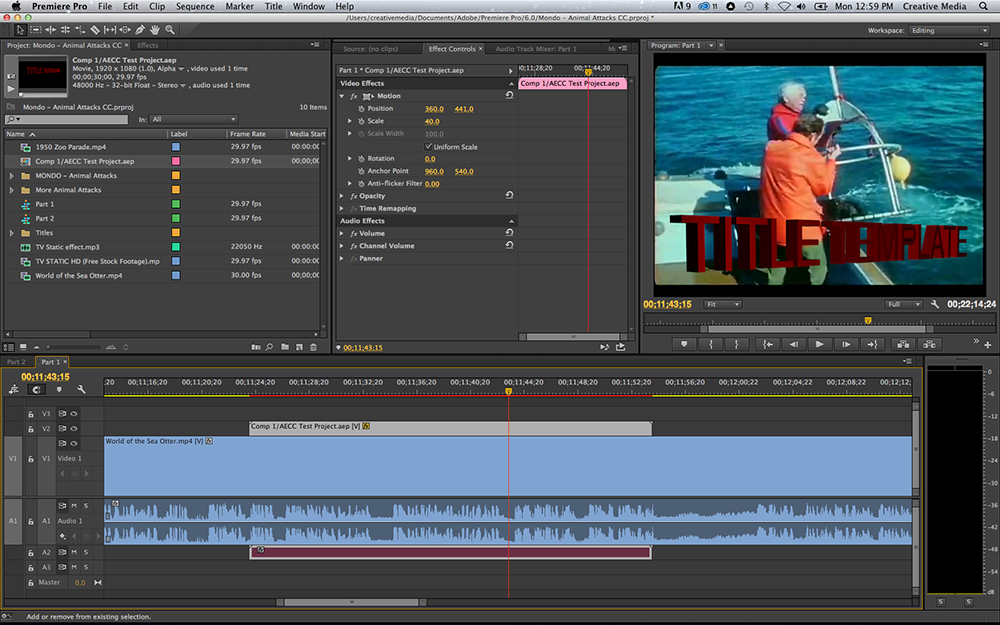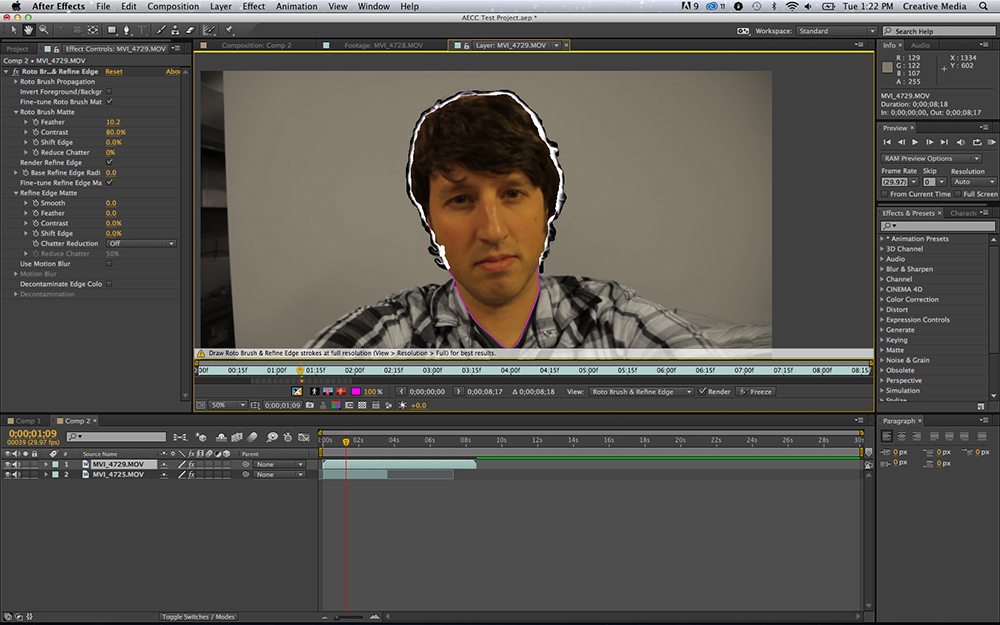After Effects CC
 Publisher: Adobe
Publisher: AdobePlatforms: Mac & PC
Description: Motion Graphics Software
Purchase/Subscription: Subscription Only
Pricing: Creative Cloud Membership
Expected Release: Available Now
Official Website: http://www.adobe.com
Samples: Click Here
Demo: Click Here
Special Discount: N/A
Review Issue: Issue #91 (09/13)
Review By: Mark Colegrove
Final Score: 9.3
The latest version of After Effects has arrived: After Effects CC, as it is now known. It is available exclusively through Adobe’s Creative Cloud subscription program, where users essentially rent the software on a monthly or yearly basis rather than owning it.
 Opinions on the Creative Cloud aside, this is a huge update for After Effects users, as the program now comes bundled with Cinema 4D Light (C4DL). C4DL is a somewhat scaled back version of Maxon’s popular 3D animation software, Cinema 4D (C4D). That news, in and of itself, makes this release a massive win for Adobe right out of the gate, since Cinema 4D is a very easy to use 3D software package and has always had a good relationship with After Effects.
Opinions on the Creative Cloud aside, this is a huge update for After Effects users, as the program now comes bundled with Cinema 4D Light (C4DL). C4DL is a somewhat scaled back version of Maxon’s popular 3D animation software, Cinema 4D (C4D). That news, in and of itself, makes this release a massive win for Adobe right out of the gate, since Cinema 4D is a very easy to use 3D software package and has always had a good relationship with After Effects.

While not as robust as the full version of Cinema 4D, Cinema 4D Light is able to create new shapes like these or, more commonly, to tweak materials and lights on pre-created C4D scenes.
Ease of Use
For longtime After Effects users, you’ll be pleased to see that just about everything is right where you left it. On the other hand, if you’re just opening After Effects for the first time, it may still be a bit intimidating. It’s a complex program that takes some time to learn and delve into. Once you do, however, you’ll find that most features are fairly intuitive and the program is designed in such a way that will make your workflow a breeze.
If you, like me, are new to Cinema 4D, you’ll probably want to check out MFM’s reviews from filmmaker and 3D guru, Mark Bremmer (who recently did background videos with Cinema 4D for the ESPY awards and NBC’s the Voice). Cinema 4D is a program that takes a bit of time to learn, so you’ll probably want to look up some video tutorials on the software—which has a very active user base. [Editor’s Note: Video Copilot’s The Bullet training software teaches you the Cinema 4D interface at the same time showcasing how to bring a cool-high end effect into After Effects. For less than $50, it’s a great way to get started, even though it’s a few years old.-JH] The fact that you can learn the basics of a powerful piece of software like Cinema 4D without shelling out $1,000 – $3,700 up front is great—since the cost of initial acquisition of a new technology is so often the biggest barrier for microfilmmakers.
Depth of Options
While After Effects has offered the ability to work with 2D elements in 3D space for a long time now, the last edition included the ability to work with 3D text and interactive light/shadow play therein, we now have the ability to work with full 3D sculptures and elements in Cinema 4D, and import them directly into After Effects via the Dynamic link. Changes made to your project file in Cinema 4D Lite, will immediately update in your After Effects composition, similar to the round-trip workflow we’ve come to rely on between Premiere Pro and After Effects.
The camera tracker, introduced in the last version of After Effects, has gone through some modification here to accommodate tracking your video in 3D space. By defining the “floor” of your moving video, data from the camera tracker imports directly into Cinema 4D, so 3D animated objects will track along with moving video in 3D space. [Editor’s note: This is especially useful because as of Cinema 4D r14, a video camera tracker was not included in Cinema 4D, so After Effects inclusion of a true 3D camera tracker is very beneficial to even the full version of C4D. – JH]
Track moving footage in true 3D space with the click of a button, import that data into Cinema 4D, and your 3D objects move along with your footage.
Performance
After Effects has been the industry standard for 2D animation for quite some time now, and with good reason. The introduction of the Global Performance Cache in the previous edition was a welcome step up, as it eliminated the need to re-render your composition every time you made a minor change.
Furthermore, the integration between Cinema 4D and After Effects is similar to the integration that After Effects has had with Premiere Pro for years now. Part of my typical workflow is to establish a set of graphic templates in After Effects, and I’ll drag them right into Premiere (where they show up just like another video clip, alpha layers and all), to render out there. Try doing that with Final Cut or Avid!

While not a new feature, of course, After Effects compositions can be imported into Premiere Pro, where they will show up like any other video clip.
One other new feature worth mentioning is the new “refine edge” tool, which was borrowed from the last few versions of Photoshop.
After Effects offers you the ability to use the rotobrush to separate a person or object from your footage (in case you forgot or were to lazy to setup a green screen). This can be met with varying results depending on what your footage looks like. A typically problematic rotobrush job occurs around a subject with frizzy hair, or trees and bushes. Now with the refine edge tool, you can quickly trace out those trouble spots in your rotobrush job, and see in the alpha layer that you’re getting all the fine details. All in all, a welcome inclusion.
Value
It can’t be said enough how big of an upgrade it is to have a version of Cinema 4D bundled with After Effects for microbudget users. Cinema 4D Prime–the most basic retail version–retails around $1000 by itself. While Cinema 4D Lite is a much more scaled down version of that software, it still puts all your basic 3D needs at your fingertips.
The other big news—and possible caveat—is that this version of After Effects is only available as part of the Creative Cloud service, the subscription service from Adobe that replaced purchasing options in May. To stay current with After Effects, or any Adobe software for that matter, you should be ready to pay $50 per month. (While you do get every piece of software in the Master Collection with this, there is currently no option for a more paired down version.)
The move by Adobe to a “cloud-only” licensing model has ignited a lot of debate, since it was quite abrupt and a number of our readers—myself included—prefer ownership of their software. Feel free to check out my review on Premiere Pro here (insert link) for my full thoughts on the issue.
Final Thoughts
In my opinion, After Effects CC offers the most noteworthy improvement over any of the other programs in the Creative Cloud release—namely, Cinema 4D Lite. Having long cornered the market in 2D motion graphic design, the partnership between Adobe and Maxon to bring true 3D graphic capabilities to After Effects is huge. It’s a smart move on Maxon’s part as well, as it could put them in a position to corner the 3D market more fully as well. I’m already curious to see what’s to come in the next upgrade from Adobe, but also from Maxon—who will be releasing their r15 software later this month!
|
Breakdown
|
|
|
Ease of Use
|
9 |
|
Depth of Options
|
10 |
|
Performance
|
10 |
|
Value vs. Cost
|
8 |
|
Overall Score |
9.3 |


